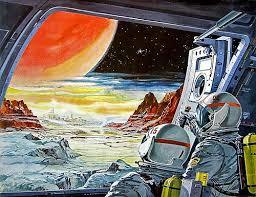What do you think?
Rate this book


256 pages, Paperback
First published May 1, 1953

All four stories in this book concern the common theme: what does it mean to be human? At least one (Gulf) is directly related to the later novel Friday and others look like precursors to other Heinlein novels. The stories are tightly written for the most part, enjoyable, and with interesting characters. All of them provide plenty of food for thought.
(I published a much longer review on my website.)
[Imported automatically from my blog. Some formatting there may not have translated here.]
Since I'd read some "new and uncut" versions of Heinlein novels recently, I thought I would put all the remaining Heinlein books on the to-be-read pile. Most of them I've read just once, umpty-ump years ago. As for this one: I found an Amazon pic of the same fifty-cent Signet edition I own. Yes, that's a very nekkid, albeit artfully blurry, lady on the cover. You could get away with that in those days.
Assignment in Eternity is a collection of four yarns (three longish, one shortish) originally published in SF mags between 1941 and 1949, two under pseudonyms. I had dim memories of the first ("Gulf") and the fourth ("Jerry was a Man"). Of the middle two ("Elsewhen" and "Lost Legacy") I had no recollection whatsoever.
Bottom line: they don't hold up that well, although there are some entertaining flights of fancy and prescient speculations about technology. Example: one character mentions another's "pocket phone". We have those now, Bob; they're just called "phones" though.
But one of the usual Heinlein tropes is here too: the wise and grumpy old fart who stops everything as he pedantically lectures some wet-behind-the-years young'un with some sophomoric-philosophical pseudo-scientific bullshit. Not to say it's wrong (although it sometimes is), but it's a lot less impressive to a guy in his sixties than it was to a lad in his teens.
"Gulf" starts out as an interplanetary secret agent yarn, but then detours into revelations about a secret race of "supermen", evolutionarily ahead of homo sapiens. They are opposed by an evil cabal, led by "Mrs. Keithley", who just happen to have gotten their hands on a doomsday device. Will the supermen be able to stop the Keithley Kabal?
"Elsewhen" is more than a little loopy, positing a multiverse (perhaps one of the earliest explications of that concept), which humans can traverse simply by a sort of self-hypnosis. The adventures of five college students and their professor, travelling between here-and-now earth and barely-recognizable alt-universes is kind of rollicking.
"Lost Legacy" is even more loopy; this time, the self-hypnosis gag is used by a trio of young people to gain superhuman powers (levitation, telepathy, accelerated healing, etc.) and insights. But it turns out to be old news, as they are psychically directed to Mt. Shasta, the redoubt of Ambrose Bierce (yes, that one) and similar supermen who have already gained those powers. They decide to bring their insights to the mass of humanity. Which would be cool, except (yet again) there's an evil cabal determined to keep mankind ignorant of their potential powers.
And finally, "Jerry was a Man" is a look into the future where genetic tinkering is the norm, and can be used to design fripperies like tiny elephants and unicorns. But a fantastically rich lady tycoon becomes aware of a race of chimps that have been bred to near-human intelligence, just enough to do all sorts of scut work. But they are doomed to a lifetime of chattel slavery, and a quick painless extermination when they become too decrepit to be profitable to their owners. Oooh! What follows is a legal battle, funded by the tycoon, to decide whether this arrangement can be maintained.
Bottom line: recommended only for people (like me) who are interested in revisiting their reading youth.